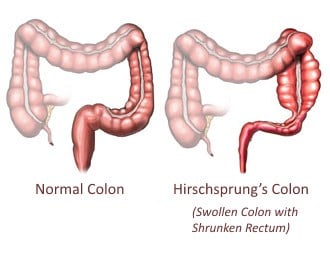 Disorders of the bowels require specific investigative techniques that are preferably non-invasive for accurate disease diagnosis. Here, the use of anorectal manometry for the diagnosis of Hirschsprung’s disease1 will be discussed.
Disorders of the bowels require specific investigative techniques that are preferably non-invasive for accurate disease diagnosis. Here, the use of anorectal manometry for the diagnosis of Hirschsprung’s disease1 will be discussed.
What is Hirschprung’s Disease?
Hirschsprung’s disease is a type of megacolon disorder, characterized by the abnormal dilation of the colon. Patients with this disease have no ganglion cells in their large intestine or in the connecting areas in their gastrointestinal tract. Paralysis of the peristaltic movements, resulting in constipation, occurs. In extreme cases of Hirschsprung’s Disease, fecal tumors form inside the colon, which require surgical removal.
Hirschsprung’s disease is primarily diagnosed shortly after birth. Affecting one in 5,000 live births, this disease is relatively rare. Most commonly, only the portion of the colon closest to the anus is affected; however, in approximately 5% of cases, the entire colon is diseased. The stomach and esophagus can also be affected.
Although Hirschsprung’s Disease is most commonly diagnosed in newborns, mild cases are sometimes not detected until childhood. In rare instances, this disease is diagnosed in adults.
In newborns, the most telling symptoms are failure to defecate within 48 hours of birth, as well as a swollen belly, vomiting, constipation, and diarrhea. In older children, symptoms of Hirschsprung’s disease are swollen abdomen, gas, chronic constipation, fatigue, and a general failure to thrive.
Treatment for Hirschsprung’s disease requires surgical removal of the affected portion of the colon. Surgery is performed laparoscopically through the anus, where the abnormal segment of the colon is removed and the healthy portion is either attached to the anus, or to an ostomy that has been surgically prepared in the abdomen, to create an ileostomy or a colostomy. In cases of a colostomy, a future surgery is required for connecting the healthy intestine to the anus.
How is Hirschsprung’s Disease Diagnosed?
There are numerous ways to diagnose Hirschsprung’s disease, including abdominal x-rays using contrast dyes, performing a biopsy on the patient’s colon tissue, and anorectal manometry.
Anorectal manometry is the least invasive diagnostic procedure and is also very simple. This test is designed to measure the patient’s contractility in his or her anus and rectum. A catheter with a balloon attached is inserted into the patient’s rectum. The balloon is inflated, and pressure readings are recorded. In the case of Hirschsprung’s Disease, anorectal manometry is used to test the ability of the surrounding muscles and tissues to relax in response to pressure. If the rectal muscles and sphincter do not relax when the balloon is inflated, paralysis of the colon is detected and Hirschsprung’s Disease is diagnosed.
Anorectal Manometry and Hirschsprung’s Disease: Research
Research has been performed to verify anorectal manometry as a suitable diagnostic tool for Hirschsprung’s Disease.
In an early study2 performed in 1980, anorectal manometry was shown to be a reliable method for diagnosis of Hirschsprung’s disease. Here, two adult patients who had suffered from constipation since birth underwent anorectal manometry. For both patients, failure to relax the internal anal sphincter was detected, which is a characteristic trait of Hirschsprung’s disease.
The diagnosis via anorectal manometry was verified with a colon biopsy that showed the absence of ganglia. From this report, anorectal manometry was determined to be a useful diagnostic tool for patients with a megacolon disorder. Another study3 performed in 1984 shows that the reliability of radiological and clinical data for the diagnoses of Hirschprung's diseases appears to be inadequate. Therefore, the diagnosis of HD can be confidently stated only on the basis of manometric investigations.
More recently, the usefulness of anorectal manometry for the diagnosis of Hirschsprung’s disease in neonate patients was examined, particularly in comparison to barium enema x-ray. In this study, 42 patients with Hirschsprung’s disease (as verified by rectal mucous membrane biopsy) underwent anorectal manometry measurements as well as barium enema x-ray testing. During anorectal manometry, the rectoanal inhibitory reflex was measured. Of the 42 patients in the study, 30 were diagnosed with Hirschsprung’s disease based on anorectal manometry measurements, including 18 patients who had negative response to the anorectal manometer and 12 who displayed abnormal response. The accuracy rate of this test was 71.43%.
In comparison, only 5 patients could be positively identified with barium enema x-ray, with an additional 14 showing suspected signs of the disease. Therefore, accuracy rate for this diagnostic tool was 45.24%. In conclusion, the researchers found that anorectal manometry is a more reliable method for diagnosing Hirschsprung’s disease in neonate patients than barium enema x-ray.
If you would like to add anorectal manometry to your practice with minimal costs and headache, click the button below.
References
- Amiel, J. (2001). Hirschsprung disease, associated syndromes, and genetics: a review. Journal of Medical Genetics, 38(11), 729-739. doi:10.1136/jmg.38.11.729 Link
- Hirsh, E. H., Hodges, K. S., Hersh, T., & McGarity, W. C. (1980, September). Anorectal manometry in the diagnosis of Hirschsprung's disease in adults. Retrieved May 11, 2017, from https://www.ncbi.nlm.nih.gov/pubmed/7468561 Link
- Ricketts, R. R. (1984). Anorectal manometry in the diagnosis of Hirschsprung's disease—Comparison with clinical and radiological criteria. Journal of Pediatric Surgery, 19(6), 885-886. doi:10.1016/s0022-3468(84)80401-7 Link


